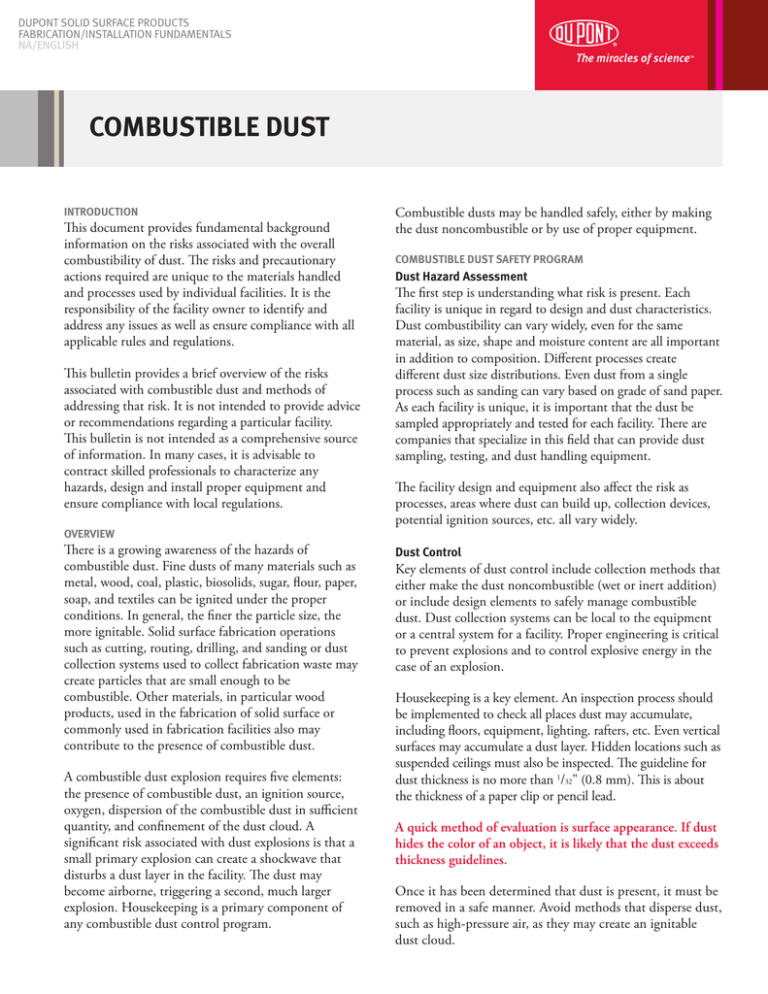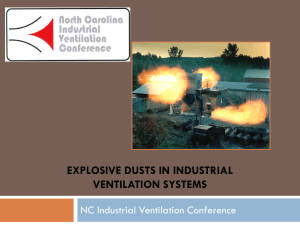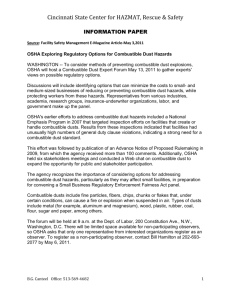
DUPONT SOLID SURFACE PRODUCTS
FABRICATION/INSTALLATION FUNDAMENTALS
NA/ENGLISH
COMBUSTIBLE DUST
INTRODUCTION
This document provides fundamental background
information on the risks associated with the overall
combustibility of dust. The risks and precautionary
actions required are unique to the materials handled
and processes used by individual facilities. It is the
responsibility of the facility owner to identify and
address any issues as well as ensure compliance with all
applicable rules and regulations.
This bulletin provides a brief overview of the risks
associated with combustible dust and methods of
addressing that risk. It is not intended to provide advice
or recommendations regarding a particular facility.
This bulletin is not intended as a comprehensive source
of information. In many cases, it is advisable to
contract skilled professionals to characterize any
hazards, design and install proper equipment and
ensure compliance with local regulations.
OVERVIEW
There is a growing awareness of the hazards of
combustible dust. Fine dusts of many materials such as
metal, wood, coal, plastic, biosolids, sugar, flour, paper,
soap, and textiles can be ignited under the proper
conditions. In general, the finer the particle size, the
more ignitable. Solid surface fabrication operations
such as cutting, routing, drilling, and sanding or dust
collection systems used to collect fabrication waste may
create particles that are small enough to be
combustible. Other materials, in particular wood
products, used in the fabrication of solid surface or
commonly used in fabrication facilities also may
contribute to the presence of combustible dust.
A combustible dust explosion requires five elements:
the presence of combustible dust, an ignition source,
oxygen, dispersion of the combustible dust in sufficient
quantity, and confinement of the dust cloud. A
significant risk associated with dust explosions is that a
small primary explosion can create a shockwave that
disturbs a dust layer in the facility. The dust may
become airborne, triggering a second, much larger
explosion. Housekeeping is a primary component of
any combustible dust control program.
Combustible dusts may be handled safely, either by making
the dust noncombustible or by use of proper equipment.
COMBUSTIBLE DUST SAFETY PROGRAM
Dust Hazard Assessment
The first step is understanding what risk is present. Each
facility is unique in regard to design and dust characteristics.
Dust combustibility can vary widely, even for the same
material, as size, shape and moisture content are all important
in addition to composition. Different processes create
different dust size distributions. Even dust from a single
process such as sanding can vary based on grade of sand paper.
As each facility is unique, it is important that the dust be
sampled appropriately and tested for each facility. There are
companies that specialize in this field that can provide dust
sampling, testing, and dust handling equipment.
The facility design and equipment also affect the risk as
processes, areas where dust can build up, collection devices,
potential ignition sources, etc. all vary widely.
Dust Control
Key elements of dust control include collection methods that
either make the dust noncombustible (wet or inert addition)
or include design elements to safely manage combustible
dust. Dust collection systems can be local to the equipment
or a central system for a facility. Proper engineering is critical
to prevent explosions and to control explosive energy in the
case of an explosion.
Housekeeping is a key element. An inspection process should
be implemented to check all places dust may accumulate,
including floors, equipment, lighting. rafters, etc. Even vertical
surfaces may accumulate a dust layer. Hidden locations such as
suspended ceilings must also be inspected. The guideline for
dust thickness is no more than 1/32" (0.8 mm). This is about
the thickness of a paper clip or pencil lead.
A quick method of evaluation is surface appearance. If dust
hides the color of an object, it is likely that the dust exceeds
thickness guidelines.
Once it has been determined that dust is present, it must be
removed in a safe manner. Avoid methods that disperse dust,
such as high-pressure air, as they may create an ignitable
dust cloud.
DUPONT SOLID SURFACE PRODUCTS
FABRICATION/INSTALLATION FUNDAMENTALS
COMBUSTIBLE DUST
Ignition Control
Proper equipment and processes must be installed to
eliminate ignition sources. Class II wiring and
equipment may be required. Open flames, smoking
and sources of sparks must be controlled. Heated
surfaces and heating systems are also a potential source
of ignition.
Training
Train employees to recognize and prevent hazards
associated with combustible dust. Conduct periodic
refresher training. Reassess the training content if
hazards or processes change.
Management
In addition to training in the recognition and
prevention of combustible hazards, management should
conduct a facilities analysis as well as develop and
implement a prevention and protection program. As
many facilities may not have the appropriate knowledge,
it is often advisable to contract companies that specialize
in combustible dust to perform hazard analyses and
develop prevention and protection systems.
It is important that changes to products, equipment,
personnel, and processes be managed so that any new or
modified hazards are identified and addressed.
Retain all documentation regarding hazard analysis,
training, equipment design, etc. Regulatory bodies and
insurance companies may request this information.
REFERENCES
You may find the following publications helpful. These
references are specific to United States code requirements,
but do include general information and guidance that may
prove useful globally. It is important to understand and
follow any local regulations.
OSHA Website, Combustible Dust – An Explosive Hazard,
U. S. Department of Labor, Occupational Safety and Health
Administration
https://www.osha.gov/dsg/combustibledust/index.html
OSHA Instruction CPL 03-00-008 Combustible Dust
National Emphasis Program (Reissued), U. S. Department of
Labor, Occupational Safety and Health Administration, 2008
https://www.osha.gov/pls/oshaweb/owadisp.show_document?p_
table=directives&p_id=3830
OSHA SHIB 07-31-2005 Combustible Dust in Industry:
Preventing and Mitigating the Effects of Fire and Explosion,
U. S. Department of Labor, Occupational Safety and Health
Administration, 2005
https://www.osha.gov/dts/shib/shib073105.html
OSHA 3371-08, Hazard Communication Guidance for
Combustible Dusts, U. S. Department of Labor,
Occupational Safety and Health Administration, 2009
http://www.osha.gov/Publications/3371combustible-dust.html
NFPA 654: Standard for the Prevention of Fire and Dust
Explosions from the Manufacturing, Processing, and Handling
of Combustible Particulate Solids, National Fire Protection
Association, 2013
http://www.nfpa.org/codes-and-standards/documentinformation-pages?mode=code&code=654
The following references may apply as fabricators may
process wood or metal, either as support structures or as
separate product lines.
NFPA 664: Standard for the Prevention of Fires and Explosions
in Wood Processing and Woodworking Facilities, National Fire
Protection Association. 2012
http://www.nfpa.org/codes-and-standards/documentinformation-pages?mode=code&code=664
NFPA 484: Standard for Combustible Metals, National Fire
Protection Association, 2012
http://www.nfpa.org/codes-and-standards/documentinformation-pages?mode=code&code=484
This information is based on technical data that E.I. du Pont de Nemours and Company and its affiliates (“DuPont”) believe to be reliable, and is intended for use by persons having technical skill
and at their own discretion and risk. DuPont cannot and does not warrant that this information is absolutely current or accurate, although every effort is made to ensure that it is kept as current and
accurate as possible. Because conditions of use are outside DuPont’s control, DuPont makes no representations or warranties, express or implied, with respect to the information, or any part
thereof, including any warranties of title, non-infringement of copyright or patent rights of others, merchantability, or fitness or suitability for any purpose and assumes no liability or responsibility
for the accuracy, completeness, or usefulness of any information. This information should not be relied upon to create specifications, designs, or installation guidelines. The persons responsible
for the use and handling of the product are responsible for ensuring the design, fabrication, or installation methods and process present no health or safety hazards. Do not attempt to perform
specification, design, fabrication, or installation work without proper training or without the proper personal protection equipment. Nothing herein is to be taken as a license to operate under or a
recommendation to infringe any patents. DuPont shall have no liability for the use of or results obtained from such information, whether or not based on DuPont’s negligence. DuPont shall not be
liable for (i) any damages, including claims relating to the specification, design, fabrication, installation, or combination of this product with any other product(s), and (ii) special, direct, indirect
or consequential damages. DuPont reserves the right to make changes to this information and to this disclaimer. DuPont encourages you to review this information and this disclaimer periodically
for any updates or changes. Your continued access or use of this information shall be deemed your acceptance of this disclaimer and any changes and the reasonableness of these standards for
notice of changes.
© E.I. du Pont de Nemours and Company 2013. All rights reserved. The DuPont Oval, DuPont™ and The miracles of science® are trademarks or registered trademarks of E.I. du Pont de Nemours
and Company (“DuPont”) or its affiliates. K-26832 12/13




